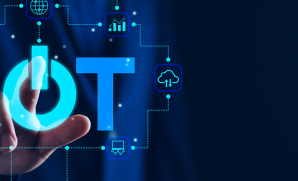Embracing the Power of Enterprise IoT: Navigating Challenges and Maximizing Value
Publish Date: August 17, 2023The global enterprise Internet of Things (IoT) market holds immense potential, offering unprecedented opportunities for businesses to enhance productivity, efficiency, and connectivity. According to German research firm IoT Analytics, the global enterprise IoT market expanded by over 20% to $157.9 billion in 2021 despite adverse conditions such as a shortage of chips and skilled workers.
The constant development of sensor technology for sensitivity, range, and resolution, coupled with improved network and speed, extended the reach of IoT networks. The connected devices help businesses gain insights that enhance operational efficiencies and reduce costs. However, despite its promising prospects, this transformative technology also confronts various challenges that hinder its widespread adoption and realization of its total value.
The decline in the supply of IoT chips since 2021 did affect the pace of some projects, and the problem was aggravated by the Russia-Ukraine conflict. The need for more skills is also a significant impediment to more widespread deployment of IoT. Some other challenges that become hurdles for enterprises trying to implement their IoT solutions are:
- Interoperability and compatibility between IoT systems
Effective integration of diverse systems is crucial for unlocking the substantial value, estimated between 40% to 60%, generated by IoT. However, the increasing number of OEMs and service providers presents a challenge in ensuring compatibility between their IoT setups. The success of IoT hinges on the efficient functioning of sensors and seamless communication.
Yet, not all devices can transmit data swiftly, leading to potential data flow bottlenecks. Furthermore, legacy machines with disparate power consumption and security standards yield inconsistent outcomes. Determining the suitable functions and components for efficient data movement within a network adds complexity. More than simply adding external sensors is required; careful consideration of specific processes and components is necessary for effective data exchange in the network.
- Technology authentication and risk management
The widespread adoption of IoT devices has introduced challenges in risk management. Organizations must consistently evaluate and classify each endpoint to assess potential threats. They must recognize that risk profiles evolve and regularly update hardware and software for ongoing security.
Additionally, safeguarding the information collected by IoT devices is crucial. Security teams must prioritize data integrity at rest, in transit, and during processing to mitigate risks effectively.
- Integration between IoT products and platforms
Seamless integration between IoT products and platforms is crucial for efficiently deploying any IoT application. Inadequate integration can result in abnormal functionalities and hinder the delivery of value to end users. The challenge lies in connecting numerous IoT assets and endpoints to aggregate and transfer data to an IoT platform.
Deep integration enables organizations to extract valuable insights from big data, generating actionable outcomes. By achieving comprehensive integration, organizations can harness the full potential of IoT and leverage data-driven decision-making to drive meaningful results.
- Managing unstructured data
The proliferation of connected devices has amplified the challenge of managing unstructured data, characterized by its significant volume, variety, and velocity. Organizations are tasked with identifying valuable and actionable data for their operations and enhancing customer experiences. Storing unstructured data in SQL format is not feasible, and retrieval becomes complex when using NoSQL formats.
Although frameworks like Hadoop and Cassandra have alleviated some complexities, integrating them with IoT platforms remains problematic due to the sheer volume of data. Furthermore, the absence of standardized data and metadata retention guidelines adds to the complexity of managing unstructured data effectively.
- Intelligent Analytics
Effective and intelligent analytics are pivotal in deriving valuable insights from IoT data. Flaws in the data model can lead to accurate results, positively influencing business decisions. Organizations must carefully select the right questions to gain meaningful insights. According to a survey by McKinsey, 38% of respondents identified a gap in analytical modeling capabilities for their IoT projects.
Traditional analytics software often needs to improve in handling real-time data. Unforeseen actions from machines impacted by security incidents can also impact analytics accuracy. Additionally, the need for more skilled professionals proficient in data mining, algorithms, and AI-ML technologies poses a significant hurdle in leveraging valuable analytics from IoT data.
Unlocking the value of enterprise IoT with YASH
Early adopters of IoT systems faced challenges such as limited demand and inconsistent standards. However, their unwavering determination stemmed from the recognition of the immense potential it held. At YASH Technologies, we firmly believe in the profound impact that IoT can have on society as a whole. Nevertheless, the journey to widespread adoption of IoT applications has encountered delays due to factors like long lead cycles, organizational inertia, chip shortages, and a shortage of skilled personnel.
However, the maturity of complementary technologies like AI, cloud computing, and 5G, combined with the pivotal role played by IoT in promoting sustainability, has created favorable conditions for enterprise IoT. YASH is a trusted business partner, guiding organizations through their IoT journeys by identifying optimal use cases, facilitating seamless deployment, mitigating risks, and optimizing analytical technologies for enhanced business intelligence. By leveraging connected ecosystems, we empower businesses to maximize the value derived from their IoT initiatives.
To learn more about how we enable enterprises to succeed in their IoT and embedded systems journey, write to us at info@yash.com.


















